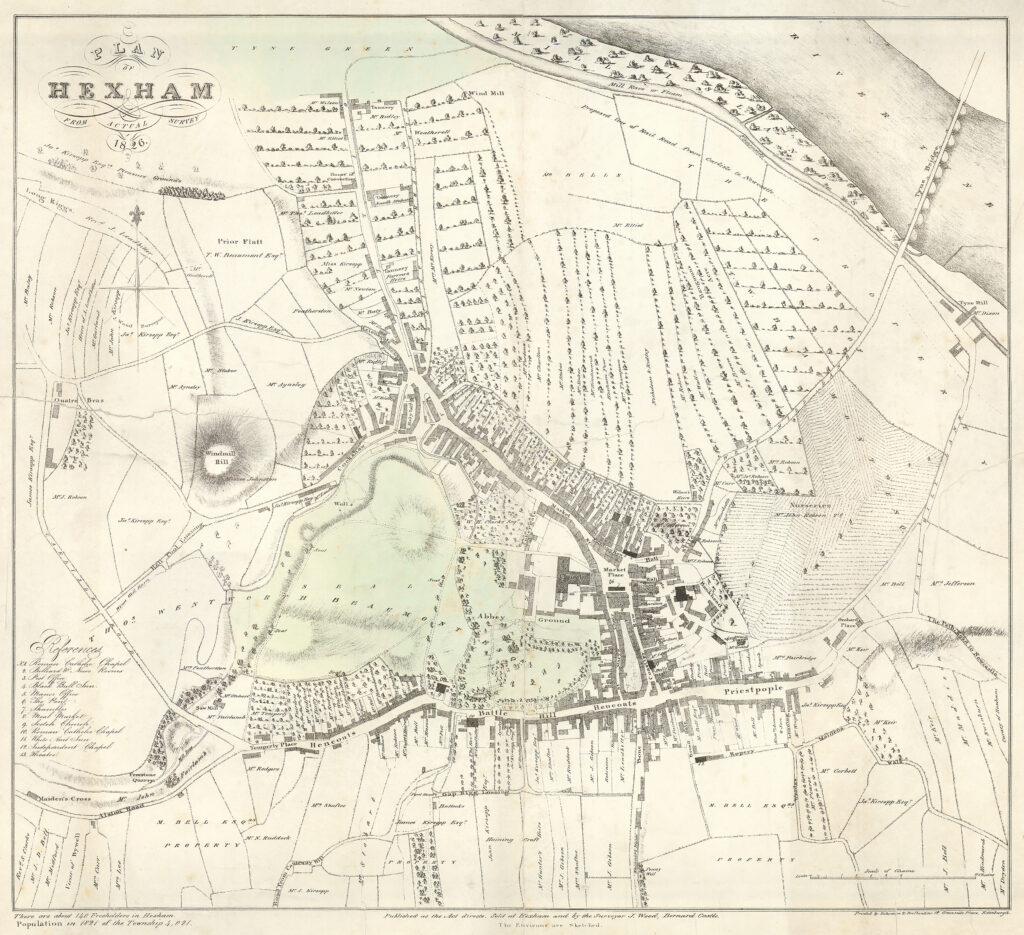What is a borough?
Reference: NRO 0324/G/5, Woods map of Hexham, 1826
CONTEXT
The word borough is used today to mean a town. In the Middle Ages a borough was a settlement that included burgage plots. Someone who held a burgage was known as a burgess and had certain rights in the settlement, including the right to elect borough officials.
Burgage plots were freehold properties, this meant that they could be bought and sold by the person that owned the freehold. They had to pay a “rent” to the lord of the manor, but this was often a small sum that did not reflect the value of the property.
Within a manor most of the land would be held by “copyhold”. Copyholders would be granted land by the lord of the manor in return for working on the lord’s own land for a certain number of days, which could vary from manor to manor. The copyholder could not sell the land that they held as they liked but had to “surrender” it to the manor court, which would then decide who would hold it next. Copyholders often had to pay “fines” when being “admitted” or when surrendering.
The legal proof of admissions and surrenders was recorded in the manor rolls (or sometimes manor court book). Tenants (copyholders) were given a copy of the entry from the manor court book/rolls.

Throughout this charter (Morpeth, 1663) the town of Morpeth is referred to as the Bailiffs and Burgesses; it was these groups that make up the “body politic”. The bailiffs were a representative of the manorial lord who collected the money owed to them by their tenants. The burgesses were freeman who owned burgages, often skilled craftsmen or merchants. The charter that this detail is from confirms the rights and privileges of the bailiffs and burgesses of Morpeth.

The “Borough Books” were the manorial roll of Hexham manor. The books record the amercements or fines that the manorial courted ordered to be paid for breaking the rules (called the “customs”) of the manor.
This detail from one of the pages of the Borough Books from 1634 shows William Todds and George Thompson being fined (amercyed) for not taking proper care of the hedge between their burgages.

We present the owners & occupiers of the garth lyeinge one [on] the
backside of wm Todds Burgage adioineinge upon the backside
of George Thompsons Burgage for the hedge or dike lyinge
downe Contrary to a former verdict & therfor amercyed – 3s 4d
GIVE IT A GO
- Compare the two documents – what can you learn about the operation and politics of boroughs and burgages from them?
- What can you infer about the manorial system from the two documents?
- Create a transcript of the documents. Our Decoding Manuscripts module provides guidance on how to read, understand, and transcribe old handwriting.
OTHER ONLINE RESOURCES
Burgages
Burgage Plots website, fantastic source of information about all aspects of burgage plots: www.burgageplots.info
Burgage Plots website, page with links to other online sources: https://www.burgageplots.info/links
Amble and District Local History website, page about Warkworth (from JC Hodgson A History of Northumberland 1899): https://www.fusilier.co.uk/warkworth_northumberland/warkworth.htm
Morpeth Conservation Area Review website, page about town’s heritage: https://morpeth-conservation-area-review-luc.hub.arcgis.com/
Royal Berkshire History for kids website, page about burgage plots (includes diagram): http://www.berkshirehistory.com/kids/burgage_plots.html
Marian L. Wilson Plan analysis of the medieval boroughs of Northumberland PhD thesis, Edinburgh, 1989 (PDF download): https://era.ed.ac.uk/bitstream/handle/1842/6884/294040.pdf?sequence=1
Manorial records
Cumbrian Manorial Records website from Lancaster University (includes glossary of manorial terms):
https://www.lancaster.ac.uk/fass/projects/manorialrecords/manors/whatis.htm
Digital Humanities Institute website (Shffield University), pages about Conisbrough Manor (includes glossary of manorial terms): https://www.dhi.ac.uk/conisbrough/index.html
Manorial Documents Register database from The National Archives: https://discovery.nationalarchives.gov.uk/manor-search
Hexham
Hexham Local History Society website, page with gallery of leather working images: https://www.hexhamhistorian.org/historic-hexham/photograph-archive/photo-archive-choices/hexham-choices/industry-and-transport-gallery/leather-gallery/


